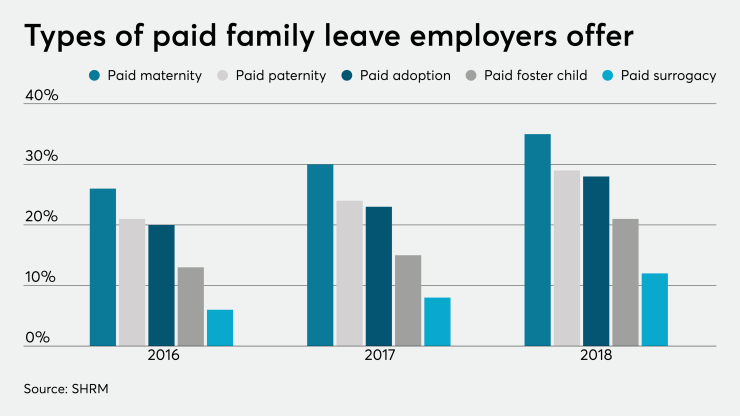This is the final in a six-part series on paid parental leave for America’s workers: how it started and where it’s going, who’s doing it well, why it’s such a challenge for employers and employees, and why it’s essential to the long-term economic growth of our country.
Imagine a world where new moms can expect two years of paid leave after the birth of a child.
That might sound incredible to American ears, but it’s no fantasy for women in Finland, Hungary, the Czech Republic and Slovak Republic — countries that offer more than 100 weeks of paid leave to mothers.
Parental leave — including both maternity and paternity leave — has been expanding dramatically around the globe in recent decades. A recent study of the 35 developed countries in the Organisation for Economic Cooperation and Development found access to paid leave for mothers averaged one year in 2016. That includes our neighbor to the north: Canada began offering 52 weeks of paid leave three years ago. And dads aren’t being left behind —most major economies in that group of 35 countries have also introduced paid father-specific leave, averaging a little more than nine weeks. Korea and Japan are in the forefront with a full year of paid parental leave for new dads.
The U.S. lags far behind but has been making progress in recent years. Several proposals are being batted around Capitol Hill, and eight states plus the District of Columbia have enacted their own paid family leave legislation. Meanwhile, corporate America — primarily tech and financial services giants along with big-name consumer brands — is leading the way with new or expanded paid leave policies in recent years.
Good for families, good for business
Many employers want to do what’s best for their employees. When it comes to paid family leave, it’s also best for the business.
- It strengthens retention. Attrition rates are lower among companies offering paid family leave. Google saw a 50% drop in employee attrition after increasing the length of its maternity leave. In California, 95% of workers who took family leave returned to work, four out of five to the same employer. Bear in mind the average estimated cost to replace an employee is more than 20% of annual salary.
- It increases productivity — and profit. One study showed 71% of employers report increased productivity from paid family and medical leave, and 82% said morale was higher. That led to higher profitability at nearly two-thirds of companies.
- It boosts recruiting. There are five generations in the workforce now, but Millennials are the biggest cohort — and they have different expectations for leave than earlier generations. High percentages of Millennials say they’re willing to change jobs, change careers, or forego a promotion to better manage their work and family responsibilities. Forty percent would even move to another country for better leave benefits.
Solutions to make leave work
To build — or expand — a competitive and compassionate paid leave program, it should be part of a comprehensive leave-management program. Consider these components:
- Include both family and medical leave. Call on outside experts if needed to create a coherent, compliant policy.
- Conduct an absence and productivity assessment. It can set a benchmark and pinpoint areas for improvement, such as departments with higher-than-average claims, potential compliance concerns or seasonal staffing needs.
- Include mental health resources. Employees on leave are often coping with a major life event that creates both physical and mental health issues. Resources such as employee assistance programs provide a pathway to counselors, care providers, financial or legal assistance and other support programs.
- Enable return-to-work programs. A robust program can help reduce workers’ compensation costs, retain talent, reduce turnover costs, and improve productivity and morale.
- Provide Social Security advocacy. Employees who can’t return to work likely need help navigating the lengthy, stressful experience of applying for Social Security Disability Insurance.
- Train supervisors and managers. Managers must understand leave policies well enough to explain them to employees at a time when they’re stressed and uncertain about their health and finances.
- Track leave activity and ensure regulatory compliance. Take advantage of tools and software programs available to reduce time spent on manual tasks and prevent problems stemming from lack of knowledge about regulatory issues.
- Get support from outside vendors. There’s no need to go it alone: Experts can help with productivity assessments, training, tracking software and other leave management services.
Your company might not be in the ranks of the mega-companies, but you can still help push the paid leave conversation. To take it a step further, not just can but should. The HR community has a great opportunity to advocate for the nation’s working parents: married, single, heterosexual, same-sex, moms, dads and everything in between. We can collaborate with our legislators to craft better leave laws, to ensure they’re optimized for effectiveness and scalability. From our position on the front lines of business, it’s our responsibility to lead the charge when it comes to assuring leave for our employees.
Anna Steffeney is the founder and president of LeaveLogic, a software company that provides family leave management solutions to major corporations.






